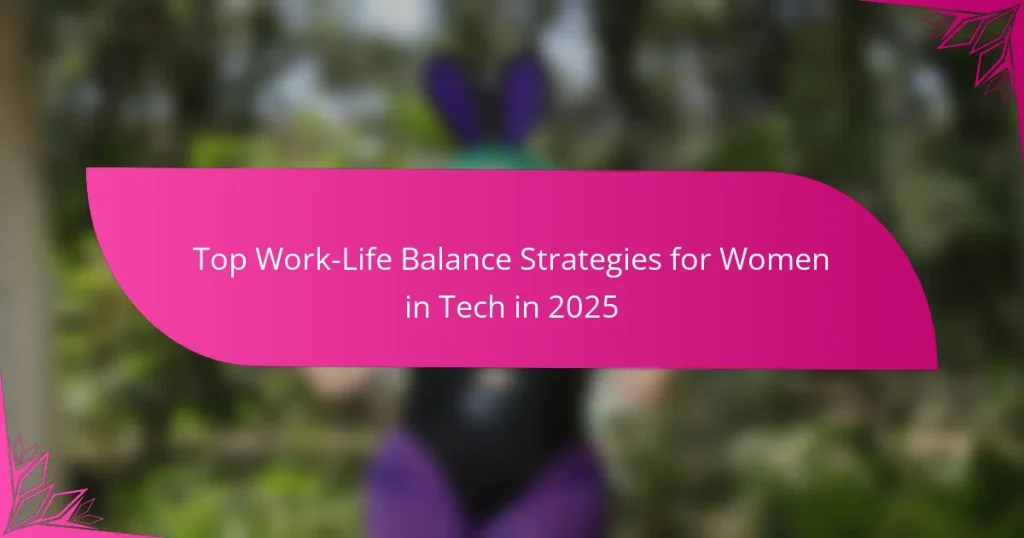As we look ahead to 2025, effective work-life balance strategies for women in tech are more crucial than ever. Emphasizing flexible work hours, remote options, and wellness programs, these strategies empower women to thrive in a demanding industry while prioritizing their personal well-being. By leveraging technology and supportive company policies, women can navigate their professional responsibilities with greater ease and satisfaction.

What are effective work-life balance strategies for women in tech in 2025?
Effective work-life balance strategies for women in tech in 2025 include flexible work hours, remote work options, time management techniques, wellness programs, and networking opportunities. These strategies help women navigate the unique challenges of the tech industry while maintaining personal well-being and professional growth.
Flexible work hours
Flexible work hours allow women in tech to tailor their schedules to fit personal commitments and peak productivity times. This approach can lead to increased job satisfaction and reduced stress. Companies can implement core hours where employees are expected to be available while allowing flexibility outside of those times.
For instance, a tech firm might offer a range of start times between 7 AM and 10 AM, enabling employees to choose what works best for them. This flexibility can be particularly beneficial for those with caregiving responsibilities or other personal obligations.
Remote work options
Remote work options provide women in tech with the ability to work from home or other locations, reducing commute times and allowing for a better work-life balance. Many companies have adopted hybrid models that combine in-office and remote work, catering to diverse employee needs.
To maximize the benefits of remote work, organizations should invest in collaboration tools and establish clear communication protocols. This ensures that remote employees remain engaged and connected with their teams, fostering a supportive work environment.
Time management techniques
Effective time management techniques are essential for women in tech to juggle multiple responsibilities. Strategies such as the Pomodoro Technique, where work is broken into intervals with short breaks, can enhance focus and productivity. Prioritizing tasks using methods like the Eisenhower Matrix helps in distinguishing between urgent and important activities.
Additionally, setting clear boundaries around work hours can prevent burnout. For example, designating specific times for checking emails or attending meetings can help maintain a structured workday.
Wellness programs
Wellness programs play a crucial role in supporting the mental and physical health of women in tech. These programs can include fitness classes, mental health resources, and stress management workshops. Companies that prioritize employee wellness often see improved morale and productivity.
Offering incentives for participation, such as gym memberships or wellness challenges, can encourage engagement. Regular check-ins and feedback on wellness initiatives can help tailor programs to meet the specific needs of employees.
Networking opportunities
Networking opportunities are vital for women in tech to build professional relationships and access mentorship. Companies can facilitate networking through events, workshops, and online platforms that connect women in the industry. These connections can lead to career advancement and support systems.
Encouraging participation in industry conferences and local meetups can also expand professional networks. Women should seek out groups focused on women in tech, which often provide resources and support tailored to their unique challenges.

How can technology enhance work-life balance for women in tech?
Technology can significantly enhance work-life balance for women in tech by providing tools that streamline tasks, improve communication, and optimize time management. By leveraging these technologies, women can better manage their professional responsibilities while maintaining personal commitments.
Productivity tools
Productivity tools help women in tech manage their time and tasks more effectively. Applications like Trello, Asana, and Notion allow for task prioritization, deadline tracking, and project management, which can reduce overwhelm and improve focus. Utilizing these tools can lead to increased efficiency, enabling women to complete work tasks more swiftly and free up time for personal activities.
When choosing productivity tools, consider features that align with your workflow. Look for integrations with other software you already use, and ensure the interface is user-friendly to minimize the learning curve. Regularly review your task lists to stay organized and avoid last-minute stress.
Collaboration software
Collaboration software facilitates communication and teamwork, which is essential for remote or hybrid work environments. Tools like Slack, Microsoft Teams, and Zoom enable real-time discussions, file sharing, and virtual meetings, making it easier to collaborate without the constraints of physical presence. This flexibility allows women to balance work obligations with personal responsibilities more effectively.
To maximize the benefits of collaboration software, establish clear communication norms within your team. Set specific times for meetings and use channels for different topics to keep discussions organized. Be mindful of time zones if working with international teams, and consider asynchronous communication methods to accommodate varying schedules.
AI-driven scheduling
AI-driven scheduling tools can significantly reduce the time spent on planning meetings and managing calendars. Applications like Calendly and Google Calendar’s smart scheduling features automatically suggest optimal meeting times based on participants’ availability, helping to minimize conflicts and streamline scheduling. This can lead to more efficient use of time and less frustration over back-and-forth communications.
When using AI-driven scheduling, ensure that you regularly update your availability to reflect changes in your commitments. Take advantage of features that allow for buffer times between meetings to prevent burnout. Additionally, consider setting limits on the number of meetings per day to maintain a healthy work-life balance.

What role do companies play in supporting work-life balance?
Companies play a crucial role in fostering work-life balance by implementing supportive policies and creating an inclusive culture. Their commitment can significantly impact employee satisfaction and retention, especially for women in tech.
Inclusive policies
Inclusive policies are essential for promoting work-life balance. Companies should consider flexible working hours, remote work options, and parental leave that accommodates both mothers and fathers. These policies not only support employees’ personal lives but also enhance productivity and morale.
For example, a tech firm might offer a hybrid work model that allows employees to choose their work environment, leading to increased job satisfaction. Additionally, ensuring that policies are communicated clearly and enforced consistently is vital for their effectiveness.
Employee resource groups
Employee resource groups (ERGs) provide a platform for women and other underrepresented groups to connect and share experiences. These groups can offer support, networking opportunities, and a sense of community, which are important for maintaining work-life balance.
Organizations can encourage the formation of ERGs focused on various aspects of diversity, such as gender, ethnicity, or parenting. By providing resources and funding for these groups, companies can empower employees to advocate for their needs and promote a more inclusive workplace culture.
Mentorship programs
Mentorship programs are effective in helping women navigate their careers in tech while balancing personal responsibilities. Pairing less experienced employees with seasoned mentors can provide guidance, encouragement, and valuable insights into achieving work-life balance.
Companies should implement structured mentorship initiatives that focus on career development and personal growth. Regular check-ins and goal-setting can help ensure that both mentors and mentees stay aligned and motivated, ultimately fostering a supportive environment for women in tech.

What are the challenges women face in achieving work-life balance in tech?
Women in tech encounter several challenges that hinder their ability to achieve a healthy work-life balance. These challenges include gender bias, workplace culture, and barriers to career advancement, all of which can create significant obstacles in their professional and personal lives.
Gender bias
Gender bias in the tech industry manifests in various forms, including unequal pay, lack of representation in leadership roles, and stereotypes about women’s capabilities. This bias can lead to women feeling undervalued and overburdened, which negatively impacts their work-life balance.
To combat gender bias, organizations should implement transparent pay structures and promote diversity in hiring practices. Women can also advocate for themselves by seeking mentorship and networking opportunities to build their professional presence.
Workplace culture
The workplace culture in tech often emphasizes long hours and constant availability, which can be particularly challenging for women who may have additional caregiving responsibilities. This culture can create pressure to prioritize work over personal life, making it difficult to maintain balance.
Companies should strive to foster a more flexible and supportive environment by offering remote work options and promoting a results-oriented approach. Women can benefit from setting clear boundaries regarding their work hours and communicating these boundaries to their teams.
Career advancement barriers
Women frequently face barriers to career advancement in tech, such as fewer opportunities for promotions and limited access to high-profile projects. These barriers can lead to feelings of stagnation and frustration, further complicating their work-life balance.
To overcome these challenges, women should actively seek out professional development opportunities and express their career goals to management. Organizations can support women by providing leadership training and ensuring equitable access to advancement opportunities.

How can women in tech advocate for better work-life balance?
Women in tech can advocate for better work-life balance by actively communicating their needs and seeking supportive policies within their organizations. This involves leveraging negotiation skills, building strong support networks, and utilizing feedback mechanisms to create a more balanced work environment.
Negotiation skills
Effective negotiation skills are essential for women in tech to advocate for work-life balance. This includes preparing for discussions about flexible working hours, remote work options, or additional leave. Practicing assertiveness and clearly articulating personal needs can lead to better outcomes.
Consider role-playing negotiation scenarios with a trusted colleague or mentor to build confidence. Researching industry standards for work-life balance can also provide leverage during negotiations, ensuring that requests are reasonable and aligned with market expectations.
Building support networks
Building support networks is crucial for women in tech to foster a culture of work-life balance. Connecting with peers, mentors, and professional organizations can provide emotional support and practical advice. These networks can also amplify voices when advocating for policy changes within companies.
Participating in women-focused tech groups or forums can help in sharing experiences and strategies. Regularly attending meetups or conferences can strengthen these connections and create opportunities for collaboration on work-life balance initiatives.
Utilizing feedback mechanisms
Utilizing feedback mechanisms allows women in tech to voice their concerns and suggest improvements regarding work-life balance. Regularly participating in employee surveys or feedback sessions can help management understand the specific needs of their workforce. This feedback can lead to actionable changes in company policies.
Encouraging open dialogue about work-life balance in team meetings can also foster a culture of transparency. Women should feel empowered to share their experiences and suggest solutions, creating a more inclusive environment that prioritizes balance for all employees.

What are the emerging trends in work-life balance for women in tech?
In 2025, emerging trends in work-life balance for women in tech focus on flexible work arrangements, mental health support, and inclusive workplace cultures. These trends aim to address the unique challenges women face in the tech industry, promoting a healthier integration of professional and personal lives.
Flexible Work Arrangements
Flexible work arrangements, including remote work and adjustable hours, are becoming increasingly popular. Many tech companies are adopting hybrid models that allow employees to choose where and when they work, which can significantly enhance work-life balance. For women, this flexibility can help manage family responsibilities while pursuing career goals.
To implement flexible work arrangements effectively, organizations should establish clear guidelines and communication protocols. Regular check-ins and performance metrics can help maintain productivity without micromanaging. Companies that prioritize flexibility often see higher employee satisfaction and retention rates.
Mental Health Support
Mental health support is a critical component of work-life balance strategies for women in tech. Companies are increasingly offering resources such as counseling services, wellness programs, and mental health days to help employees manage stress and burnout. This support is essential for fostering a healthy work environment.
Employers should encourage open discussions about mental health and create a stigma-free culture. Providing training for managers on recognizing signs of mental health issues can also be beneficial. By prioritizing mental well-being, companies can enhance overall productivity and employee morale.
Inclusive Workplace Cultures
Creating inclusive workplace cultures is vital for improving work-life balance for women in tech. Organizations that promote diversity and equality tend to have more supportive environments, which can help women feel valued and empowered. This includes implementing policies that address gender bias and support career advancement.
To foster inclusivity, companies should actively seek diverse talent and provide mentorship programs for women. Regular diversity training and feedback mechanisms can help ensure that all employees feel respected and included. A strong commitment to inclusivity not only benefits women but enhances the overall workplace culture.


